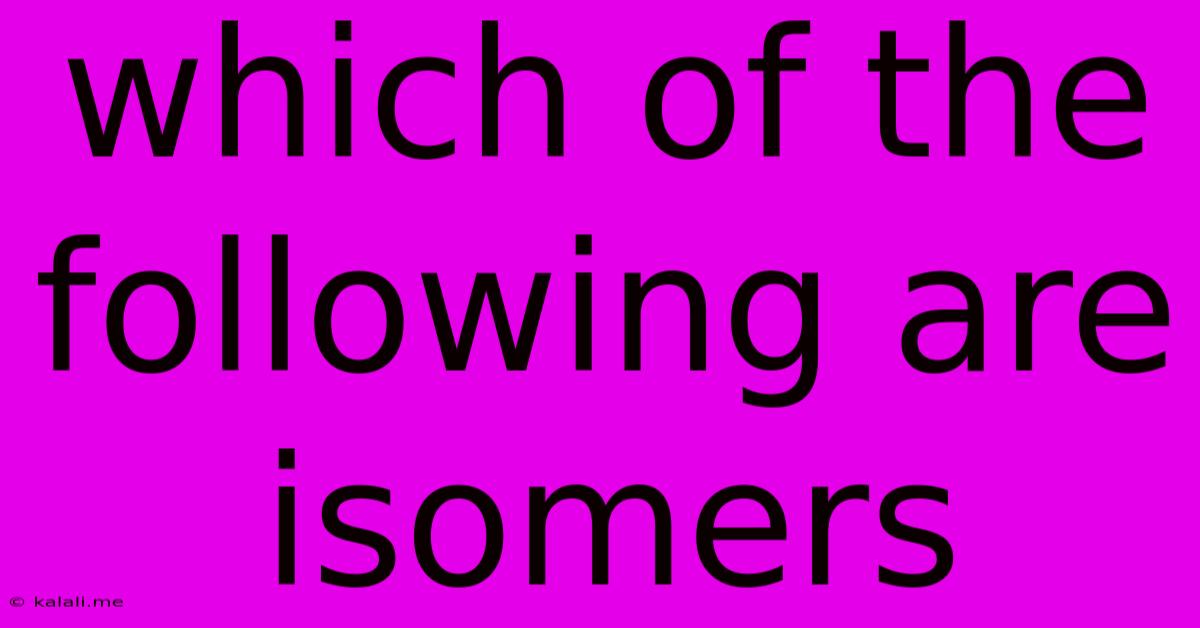Which Of The Following Are Isomers
Kalali
Jun 15, 2025 · 3 min read

Table of Contents
Which of the Following are Isomers? A Comprehensive Guide
Isomers are molecules that share the same molecular formula but have different arrangements of atoms. This seemingly small difference can lead to vastly different properties, making understanding isomers crucial in chemistry and related fields. This article will delve into the concept of isomerism, exploring different types and providing examples to help you identify isomers.
What are Isomers?
Isomers are molecules that possess the same molecular formula but differ in the arrangement of their atoms in space. This seemingly minor difference can drastically alter their physical and chemical properties. Think of it like using the same set of LEGOs to build two completely different structures – they use the same pieces (atoms), but the final products are distinct.
Types of Isomerism:
Isomerism is broadly classified into two main categories:
1. Structural Isomerism (Constitutional Isomerism):
Structural isomers differ in the way atoms are connected. There are three main types of structural isomerism:
-
Chain Isomerism: This involves a difference in the carbon skeleton's branching. For example, butane (CH₃CH₂CH₂CH₃) and methylpropane (CH₃CH(CH₃)CH₃) are chain isomers. They have the same formula (C₄H₁₀) but different arrangements of carbon atoms.
-
Position Isomerism: This type involves a difference in the position of a functional group or substituent on the carbon chain. For example, 1-chloropropane (ClCH₂CH₂CH₃) and 2-chloropropane (CH₃CHClCH₃) are position isomers. Both have the formula C₃H₇Cl, but the chlorine atom is attached to different carbon atoms.
-
Functional Group Isomerism: This involves isomers having different functional groups. For example, ethanol (CH₃CH₂OH) and dimethyl ether (CH₃OCH₃) are functional group isomers. Both have the formula C₂H₆O but have different functional groups (alcohol vs. ether).
2. Stereoisomerism:
Stereoisomers have the same connectivity of atoms but differ in their spatial arrangement. This includes:
-
Geometric Isomerism (cis-trans isomerism): This occurs in molecules with restricted rotation, such as those containing double bonds or rings. Cis isomers have similar groups on the same side of the double bond or ring, while trans isomers have them on opposite sides. For example, cis-2-butene and trans-2-butene.
-
Optical Isomerism (Enantiomerism): This occurs in chiral molecules, those that are non-superimposable mirror images of each other. These isomers are called enantiomers and have different effects on polarized light. A common example involves molecules with a chiral carbon atom (a carbon atom bonded to four different groups).
Identifying Isomers:
To determine if two molecules are isomers, follow these steps:
-
Determine the molecular formula: Count the number and type of each atom in each molecule.
-
Compare molecular formulas: If the formulas are different, the molecules are not isomers.
-
Analyze the connectivity: If the formulas are the same, examine the arrangement of atoms. Differences in connectivity indicate structural isomerism.
-
Consider spatial arrangement: If the connectivity is the same, consider the spatial arrangement of atoms. Differences indicate stereoisomerism.
Examples:
Let's consider a few examples to solidify our understanding. Are the following pairs of molecules isomers?
-
Molecule A: C₂H₆O; Molecule B: C₂H₄O₂: These are not isomers because their molecular formulas differ.
-
Molecule C: CH₃CH₂CH₂OH; Molecule D: CH₃CH(OH)CH₃: These are isomers, specifically position isomers. Both have the formula C₃H₈O, but the hydroxyl group (-OH) is in a different position.
-
Molecule E: CH₃CH=CHCH₃ (cis); Molecule F: CH₃CH=CHCH₃ (trans): These are isomers, specifically geometric isomers (cis-trans isomers). They have the same molecular formula but differ in the spatial arrangement around the double bond.
By understanding the different types of isomerism and applying a systematic approach, you can confidently identify whether a pair of molecules are isomers. This knowledge is fundamental to various aspects of chemistry, including organic chemistry, biochemistry, and medicinal chemistry.
Latest Posts
Latest Posts
-
Which Of The Following Is Not A Strong Base
Jun 16, 2025
-
The Atomic Number Is Determined By The Number Of
Jun 16, 2025
-
Normal Profit Is Also Known As Economic Profit
Jun 16, 2025
-
What Is A Factor Of 50
Jun 16, 2025
-
What Is The First Five Multiples Of 9
Jun 16, 2025
Related Post
Thank you for visiting our website which covers about Which Of The Following Are Isomers . We hope the information provided has been useful to you. Feel free to contact us if you have any questions or need further assistance. See you next time and don't miss to bookmark.